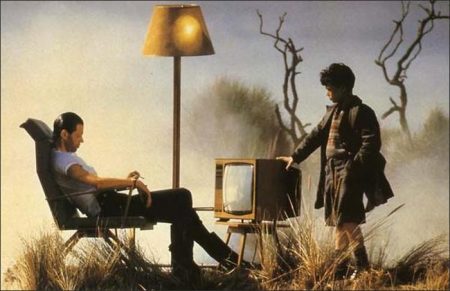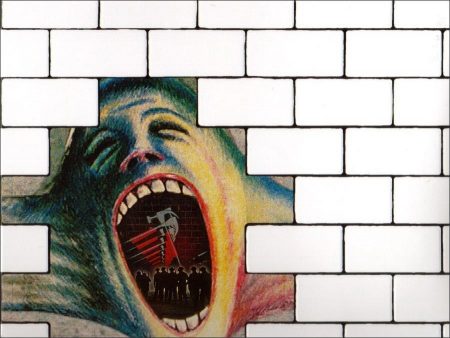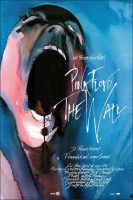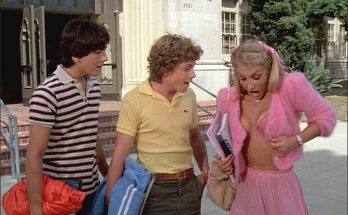Taglines: Pink Floyd The Wall. Now The Film.
Pink Floyd: The Wall tells the story of rock singer “Pink” who is sitting in his hotel room in Los Angeles, burnt out from the music business and only able to perform on stage with the help of drugs. Based on the 1979 double album “The Wall” by Pink Floyd, the film begins in Pink’s youth where he is crushed by the love of his mother.
Several years later, he is punished by the teachers in school because he is starting to write poems. He slowly begins to build a wall around himself to be protected from the world outside. The film shows all this in massive and epic pictures until the very end where he tears down the wall and breaks free.
Pink Floyd – The Wall is a 1982 British live-action/animated musical drama film directed by Alan Parker with animated segments by political cartoonist Gerald Scarfe, and is based on the 1979 Pink Floyd album of the same name. The film centers around a confined rocker named Pink, who, after being driven into insanity by the death of his father and many depressive moments during his lifetime, constructs a metaphorical (and sometimes physical) wall to be protected from the world and emotional situations around him. When this coping mechanism backfires he puts himself on trial and sets himself free. The screenplay was written by Pink Floyd vocalist and bassist Roger Waters.
Like its musical companion, the film is highly metaphorical and symbolic imagery and sound are present most commonly. However, the film is mostly driven by music, and does not feature much dialogue. Gerald Scarfe drew and animated 15 minutes of animated sequences, which appear at several points in the film.
It was the seventh animated feature to be presented in Dolby Stereo. The film is best known for its disturbing surrealism, animated sequences, sexual situations, violence and gore. Despite its turbulent production and the creators voicing their discontent about the final product, the film has since fared well generally, and has established cult status.
About the Story
Pink, the protagonist, is a rock star, one of several reasons behind his apparent depressive and detached emotional state. He is first seen in an unkempt hotel room, motionless and expressionless, watching television while the Vera Lynn recording of “The Little Boy that Santa Claus Forgot” plays. It is later revealed that Pink’s father, a British soldier, was killed in action while defending the Anzio bridgehead during World War II, in Pink’s infancy.
In a flashback, Pink is a young English boy growing up in the early 1950s. Throughout his childhood, Pink longs for a father figure. He discovers a scroll from “kind old King George” and other relics from his father’s military service and death, placing a bullet on the track of an oncoming train. At school, he is caught writing poems in class (the poem being Pink Floyd’s “Money”) and humiliated by the teacher.
To the tune of “Another Brick in the Wall (Part 2)”, Pink imagines a surrealistically oppressive school system in which children fall into a meat grinder. The children then rise in rebellion and destroy the school, carrying the Teacher away to an unknown fate. Pink is also negatively affected by his overprotective mother. Such traumatic experiences are represented as “bricks” in the metaphorical wall he constructs around himself that divides him from society.
As an adult, Pink eventually marries, but he and his wife soon grow apart. While he is in the United States on tour, Pink learns that his wife is having an affair. He turns to a willing groupie, whom he brings back to his hotel room only to trash it in a fit of violence, terrifying the groupie out of the room.
Pink slowly begins to lose his mind to metaphorical “worms”. He shaves all his body hair and, while watching The Dam Busters on television, morphs into a neo-Nazi alter-ego. Pink’s manager, along with the hotel manager and some paramedics, discover Pink unresponsive and inject him with drugs to enable him to perform.
Pink fantasises that he is a dictator and his concert is a neo-Nazi rally. His followers proceed to attack ethnic minorities, and Pink holds a rally in suburban London, singing “Waiting for the Worms”. The scene is intercut with images of animated marching hammers that goose-step across ruins. Pink then stops hallucinating and screams “Stop!” He then takes refuge in the toilets at the concert venue, reciting poems.
In a climactic animated sequence, Pink, depicted as a small, almost inanimate rag doll, is on trial, and his sentence is “to be exposed before [his] peers.” The judge gives the order to “tear down the wall”. Following a prolonged silence, the wall is smashed. Several children are seen cleaning up a pile of debris after an earlier riot, with a freeze-frame on one of the children emptying a Molotov cocktail.
Pink Floyd: The Wall (1982)
Directed by: Alan Parker
Starring: Bob Geldof, Christine Hargreaves, James Laurenson, Eleanor David, Jenny Wright, Bob Hoskins, evin McKeon
Screenplay by: Roger Waters
Production Design by: Brian Morris
Cinematography by: Peter Biziou
Film Editing by: Gerry Hambling
Costume Design by: Penny Rose
Art Direction by: Chris Burke, Clinton Cavers
Music by: Roger Waters
Distributed by: Metro Goldwyn Mayer, United Artists
Release Date: July 15, 1982
Views: 282





